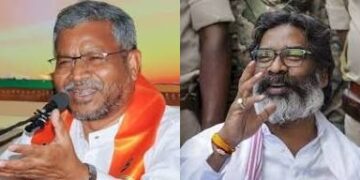SWAMI DIVYAGYAN
Ranchi, Oct. 29: With the Jharkhand Assembly elections on the horizon, the state is witnessing a tightly contested battle between the Bharatiya Janata Party (BJP) and Jharkhand Mukti Morcha (JMM). Both parties are drawing on unique strengths and coalition dynamics to sway voters.
While the JMM leans on its deep tribal roots and regional identity, the BJP banks on national issues and development promises. As the leaders of the INDIA coalition and NDA alliance respectively, JMM and BJP’s strategies are marked by carefully crafted alliances and targeted voter outreach.
JMM’s Traditional Approach
The JMM’s campaign focuses on strong tribal identity and grassroots support, particularly in rural and tribal-dominated regions. With its emphasis on local issues like land rights, employment, and education, the JMM maintains a close emotional bond with Jharkhand’s rural communities. Chief Minister Hemant Soren, perceived as a dedicated tribal leader, further strengthens the JMM’s image by championing the cultural identity and rights of indigenous communities. This connection has solidified a loyal base, particularly among the state’s tribal population.

Also Read: Jharkhand News: SE Railway to run three special trains for Diwali and Chhath
The JMM’s partnership with the INDIA coalition, which includes the Congress and other left-leaning allies, helps the party extend its reach to urban and minority regions where the BJP’s influence traditionally falters. However, the JMM faces challenges as it seeks to expand its appeal beyond tribal areas. Its influence remains limited in urban and non-tribal regions, despite recent efforts to broaden its platform.
Furthermore, the JMM’s development agenda has often lacked the large-scale infrastructure projects that attract urban voters, which could push these segments toward the BJP’s development-focused promises. While the JMM’s emphasis on local issues resonates in tribal areas, it may fall short in engaging non-tribal, youth and urban populations attracted to the BJP’s national themes like security and economic growth.
BJP’s Multi-Faceted Strategy
The BJP, on the other hand, employs a broad appeal that focuses on Hindutva, national security, and large-scale development projects. This approach has resonated well with urban and non-tribal demographics, widening its reach beyond its traditional voter base. With a focus on infrastructure and economic growth, BJP positions itself as the party for educated, urban voters who prioritize development, securing a stronghold in Jharkhand’s developed areas.
The BJP’s campaign also includes a Hindutva-driven narrative aimed at uniting Hindu voters across tribal and non-tribal communities. Leaders like Himanta Biswa Sarma have emphasised “external threats” such as illegal immigration, and merging state security concerns with cultural identity.
However, the BJP faces challenges in connecting deeply with Jharkhand’s tribal communities, where the JMM holds significant sway. Additionally, its Hindutva-driven approach risks communal tensions, potentially alienating minority and tribal groups and consolidating support for the JMM and its allies. The BJP’s limited appeal among minority voters may pose a hurdle in tribal regions where JMM remains dominant.
A Competitive Battle Ahead
As the BJP and the JMM prepare for the elections, both are working to expand their voter appeal while addressing core weaknesses. The JMM banks on its cultural identity, grassroots issues, and coalition support, while the BJP seeks urban and non-tribal votes through its development narrative and Hindutva themes. For the JMM, bridging the gap in urban areas with a strong development agenda is crucial, while the BJP must work on resonating more deeply with the state’s tribal identity.
The upcoming election results are set to reveal Jharkhand’s voter priorities, answering whether the state will lean towards JMM’s localized identity and issues or BJP’s national and development-focused vision for the future.










